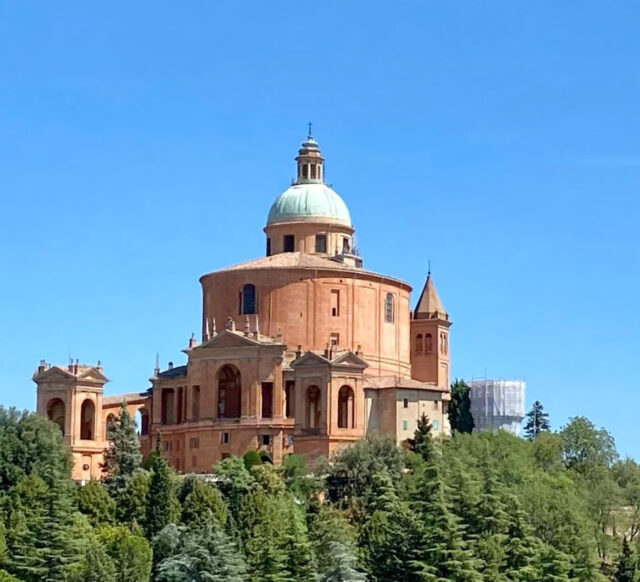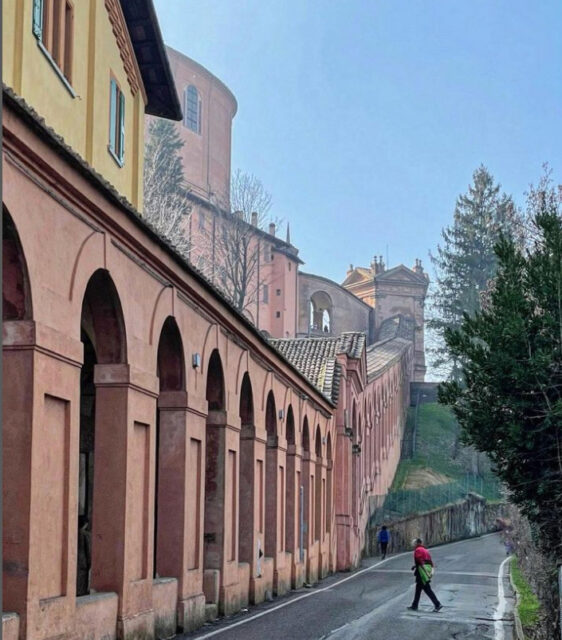Santuario San Luca
Santuario San Luca. Since 1100 A.D. sources have referred to a hermitage located on this hill, famous for a specific hermit called Euthymius who arrived from Constantinople carrying a cedar board with an ancient Byzantine image of the Virgin painted upon it. In 1149 the hermitage passed to two sisters, Azzolina and Bice, daughters of Rampertino di Gherardi di Guezo.
The two sisters were joined by other young women who wished to spend their lives in prayer. In 1741, with the consent of the Municipality and many devoted benefactors, construction began on the Sanctuary as we see it today. Designed by Carlo Francesco Dotti, construction was nearly completed by 1757, while the façade foundations and side galleries were installed soon after.


The building, circular in shape with short Greek cross arms, has a single nave and a grandiose appearance created by the large drum supporting its majestic dome. The paintings inside are from the 17th-century Bolognese school and include works by excellent artists such as Guido Reni (who painted a wonderful Madonna del Rosario found in the third chapel on the right), the Bigari, Giovanni Viani, Nicola Bertoni, and other notable local artists.
The sculptures were provided by Angelo Pió and Cometti, the latter being responsible for the two beautiful statues of San Luca and San Marco on either side of the main entrance. The central altar was erected in 1815 according to a design by Venturoli, and richly decorated with marble and bronze.
Behind the presbytery, you can enter an apse via a small staircase to reach a small niche containing the precious icon. The sacred image is a pilgrimage destination, not only for devoted Bolognese who reach it by following the long portico but also for pilgrims traveling from all over the country.
The Sanctuary is reached from the city center by following the world’s longest portico, beginning with the first arch at Porta Saragozza.
The Sanctuary of San Luca Bologna stands on the top of Colle della Guardia, about 300 meters above sea level, and dominates the capital of Emilia and the whole plain below. It is a point of reference for all the Bolognese and beyond: it can already be seen in the distance as you drive along the motorway towards the city.


The Basilica of San Luca is also an important place of worship and pilgrimage: in fact, it can be reached on foot from Porta Saragozza along the longest portico in the world with its 666 arches, 15 chapels, and 3796km.
According to some observers, the fact that it is made up of exactly 666 arches is no coincidence: the diabolical number (cf. Apocalypse, 13, 18) would have been used to indicate that the portico symbolizes the “serpent”, i.e. the devil, both for its shape and because ending at the foot of the sanctuary, it recalls the traditional iconography of the Devil defeated and crushed by the Madonna under her heel.
The portico of San Luca can be divided into two sections:
The first part starts from Porta Saragozza, located about a kilometer from Piazza Maggiore, up to Meloncello, through the first 316 arches for 1.5 km on flat ground. The Meloncello is one of the most famous architectures of Bologna, a city crossroads, not only for those who go to the Sanctuary of San Luca, but also for those who go to the Stadio dall’Ara located a few hundred meters away.
The second part of the Marian path starts from Meloncello, all uphill for about 2.2 km. The number of arches increases, to 350, and every twenty you come across one of the 15 chapels that are distributed along the portico until you reach the Sanctuary of San Luca.
Today it is no longer the religious reason that brings thousands of citizens and visitors a year to the Madonna di San Luca sanctuary: the stretch that starts from Via Saragozza to the Basilica of San Luca is usually covered on foot, it takes about 45 minutes, and running, it depends on your training!
“If it suits me this time, I’ll go to San Luca on foot!” It is one of the typical affirmations of the Bolognese. More




